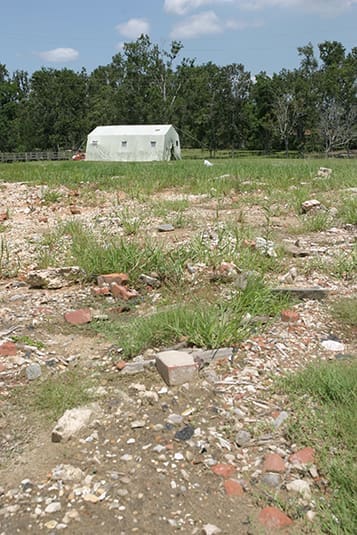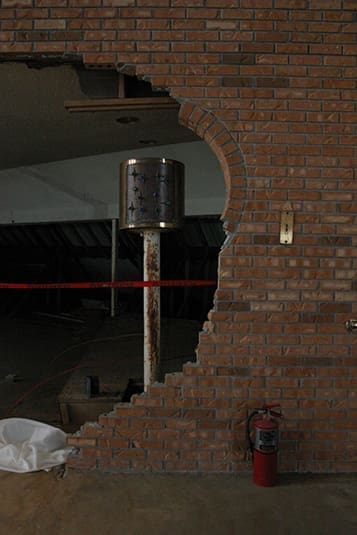At first glance this looks like it could be a plaza connected to Our Lady of Lourdes Church, Slidell, La., but the large open area was actually the interior of the church. Hurricane Katrina blew off its large, steep pitched roof. The church was a congregation of 1,700 people before the natural disaster. Nearly a year later, this parish of some 900 people is left with an empty shell of a church building. The parish, which has received hurricane relief from various sources, including Holy Cross Church, Atlanta, has a building committee in place to take on rebuilding efforts. Photo By Michael Alexander
Washington
A Year After Hurricanes, Dioceses Still Recovering
By CAROL ZIMMERMANN, CNS | Published August 24, 2006
Southern dioceses from Texas to Alabama are still reeling from the swath of destruction left by last year’s hurricanes Katrina and Rita.
The Archdiocese of New Orleans and the Diocese of Biloxi, Miss., both hit hard by Hurricane Katrina Aug. 29, have taken steps toward recovery, but full-scale restoration is still a long way off as thousands of residents no longer have a place to live, churches and schools remain damaged and community service programs are no longer operational.
The coastal area of the Archdiocese of Mobile, Ala., is also in the midst of recovery. Church structures have been repaired, but residents of the small fishing village of Bayou La Batre, Ala., are still living in trailers and trying to salvage what they can from destroyed homes and fishing livelihoods.

This is the site where parishioners at St. Peter the Apostle Church, Pascagoula, have worshipped since 1907. The tent in the background holds some of the articles the Josephite parish tried to salvage after Hurricane Katrina decimated the church. Photo By Michael Alexander
Farther west at the Texas-Louisiana border, the impact of Hurricane Rita, which slammed the area Sept. 24, is evident in ongoing repair work. In the dioceses of Beaumont, Texas, and Houma-Thibodaux, La., there has been a flurry of repairs of homes, schools and churches, but in a storm-devastated area of the Diocese of Lake Charles, La., repairs are only just beginning.
“The needs are still as great as ever,” said Margaret Dubuisson, communication director for Catholic Charities in New Orleans. “If anything, the needs are greater as people come home or attempt to come home.”
The agency continues to provide immediate relief with food, medical care and shelter, but it is also inundated with long-term recovery needs from counseling to housing. The agency has been involved in gutting destroyed homes, remodeling apartments for the elderly and helping establish new communities.
“We don’t build levees, but if we did, we’d be right out there,” Dubuisson told Catholic News Service in a telephone interview.
The New Orleans Archdiocese was hit with $120 million in uninsured losses alone and is in the midst of the arduous process of repairing wind- and flood-damaged schools and churches. Six churches have been permanently closed and 23 have closed temporarily. A number of churches are still undergoing repairs, and 24 churches and one mission that sustained extensive flooding damage have reopened. Sixteen schools are still closed and 21 have remained open while being repaired.
Although the archdiocese has filed paperwork with the Federal Emergency Management Agency in the hopes of being reimbursed for costs associated with the rebuilding of schools and other nonworship facilities, it is unclear how much the archdiocese will eventually receive. FEMA will not pay to rebuild church buildings.
The Biloxi Diocese suffered property damage of $70 million and only half of the damage is covered by insurance. Thirteen churches were damaged, and three of them will not reopen. The future of one church is currently undetermined. Five are using temporary locations until their buildings can be repaired and four have been in use while undergoing major repairs.
Katrina also destroyed five schools and damaged 10. The diocese consolidated six schools into three and has been doing repair work on 10 schools that remain open.

A shattered brick wall exposes the back of the tabernacle at St. Paul Church, Pass Christian, Miss. Photo By Michael Alexander
The new school year in the Biloxi Diocese started in early August, and according to Mike Ladner, diocesan superintendent of schools, crisis management plans have been finalized, buildings have been modified—with electrical outlets placed higher off the floors and away from future flooding—and school officials have been advised to take school records with them to a dry place in the event of another hurricane.
In Biloxi and other areas, many are taking to heart what they would do differently in the face of a hurricane, but they are also hoping just to get their lives back to where they were prior to the storms.
That’s the case even in Texas, where Karen Gilman, editor of the East Texas Catholic, Beaumont’s diocesan newspaper, noted that nearly a year later “life is not back to normal.”
Although Rita was overshadowed by Katrina, its destruction can’t be dismissed by local residents now accustomed to the ever-present blue tarps marking signs of repair. In Beaumont, one church closed because of hurricane damage and five closed temporarily for ongoing repairs. One Catholic school closed but will reopen for the upcoming school year.
Just prior to Hurricane Rita, the Louisiana dioceses of Houma-Thibodaux and Lake Charles were busy assisting Katrina evacuees. Although Katrina inflicted minimal damage on the Houma-Thibodaux Diocese, Rita flooded more than 10,000 homes. As a result of both hurricanes, seven Catholic schools and eight parishes in the diocese were damaged, but have since been repaired and are currently functional.
In the Lake Charles Diocese, Rita caused severe damage in several counties and its strong wind and storm surges essentially flattened the civil entity of Cameron Parish, a region that includes five parishes and five mission churches, nine of which had been temporarily closed because of storm damage.

A statue of the Virgin Mary leans up against a housing unit in New Orlean’s Lower 9th Ward. Photo By Michael Alexander
Currently, three damaged churches are in the very early stages of repair, after gaining approval from the local government, the Army Corps of Engineers and FEMA. For the past several months, the mission chapel of St. Patrick, a mission of St. Mary of the Lake Church in Big Lake, has been the only church in the civil entity of Cameron Parish safe enough to have Masses on a regular basis.
“It’s still a very difficult time for many people,” said Morris LeBleu, director of communications for the diocese and editor of its diocesan newspaper, The Southwest Catholic. He noted that only about 5 percent to 6 percent of the residents of Cameron Parish have returned.
On July 23, for the first time since Hurricane Rita, a Sunday Mass was celebrated at Our Lady Star of the Sea in Cameron. Parishioners brought their own chairs and prayed together in the empty shell of the church.
“It was good to see the church and be in it and worship,” LeBleu said, even if it will be a long time before parishioners will actually be inside the church as it once was.
Contributing to this story was Peter Finney Jr. in New Orleans.
